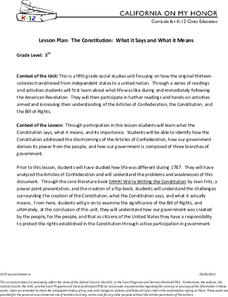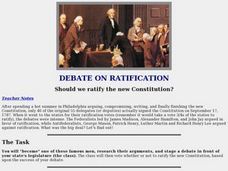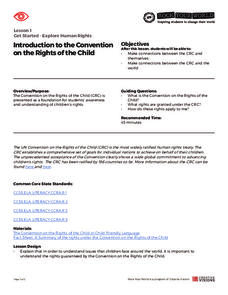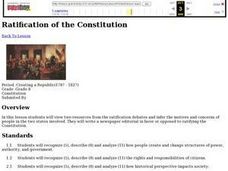National Endowment for the Humanities
Ratifying the Constitution
Ratifying the Constitution was no simple task. Using primary sources, such as classic writings from the Federalists and Anti-Federalists, young scholars examine the arguments for and against the Constitution. They then decide: Would they...
Curated OER
Ratifying the Constitution
After a lecture on ratifying the Constitution, this worksheet would be perfect to reinforce your government (or U.S. History) students' new knowledge. The activity contains ten knowledge-level and comprehension-level questions. This...
DocsTeach
The Amendment Process: Ratifying the 19th Amendment
The process for adding an amendment to the U.S. Constitution is long and arduous, by design. High School historians study a series of documents about the Nineteenth Amendment and, using an interactive program, drag the documents onto a...
National Woman's History Museum
19th Amendment
As part of a study of the women's suffrage movement and the ratification of the Nineteenth Amendment, young historians examine documents that detail when voting rights were granted to women in various countries and when US states...
Judicial Branch of California
The Constitution: What It Says and What It Means
Learners get the chance to act as representatives to the Constitution Convention, and must decide whether or not to recommend your state ratify the new framework. After examining the Constitution line-by-line, they consider their...
Curated OER
Debate on Ratification: Should We Ratify the New Constitution?
Students determine whether the Constitution should be ratified. In this U.S. Constitution lesson, students research the roles of famous Federalists and Antifederalists in order to prepare them to participate in a classroom simulation...
Curated OER
The Bill of Rights: Debating the Amendments
Provide your class with an opportunity to investigate an important historical document. Without identifying the document, distribute copies of the original Bill of Rights, as transcribed by John Beckley, Clerk of the House of...
Tennessee State Museum
Understanding Women’s Suffrage: Tennessee’s Perfect 36
Tennessee was the pivotal state in ratifying women's suffrage in 1920, with its vote coming down to one man: Harry Burn, a 24-year old state representative who changed his nay to an aye on the advice of his mother. Learn more about...
Creative Visions Foundation
Introduction to the Convention on the Rights of the Child
The UN Conventions on the Rights of the Child (CRC) has been ratified by 196 countries so far ... and still counting! Using the first of two lessons covering the Introduction to the Convention on the Rights of the Child, scholars learn...
National Woman's History Museum
The Equal Rights Amendment
The debate over the Equal Rights Amendment continues. To better understand the controversy, class members research the history of attempts to get the amendment ratified. In addition, pairs engage in a structured academic conversation...
Judicial Branch of California
Articles of Confederation…Well, They Were Trying!
Different currencies, multiple armies, unreliable protection from thieves: class members experience these challenges playing a game that demonstrates life under the Articles of Confederation. After playing the game—which takes them on a...
Curated OER
Arguments Against Ratifying the Constitution
Young scholars define federalism, Federalist, and Anti-Federalist, debate issue of ratification in classroom convention, and take vote on whether to add bill of rights. Three lessons on one page.
National Endowment for the Humanities
Lesson 2: Chief Executives Compared: The Federalist Papers
Fix the Articles of Confederation or develop a new constitution? That was the question facing the Founding Fathers. Several of those in favor of a new constitution published a series of essays, collected in the Federalist Papers, urging...
National First Ladies' Library
Forming a League of Nations
Young scholars identify and research the original language as composed by Woodrow Wilson in his League of Nations. Then they identify and describe the revisions of the original League of Nations as the United Nations was created....
Curated OER
Constitutional Struggle Over Centralized Power
Students participate in a classroom simulation to discover the issues facing those who formed the new U.S. government. They compare and contrast the Articles of Confederation and the Constitution. Using resource sheets and working in...
Curated OER
Declaration of Independence
Young scholars define the words: republic, Articles of Condederation, survey, Northwest Ordinance, republicanism, ordinance, ratified, and Northwest Territory. They view the video Charlie Brown Constitution.
Curated OER
Paving the Road to the Constitution
Eighth graders argue for or against the ratification of the U.S. Constitution. In this U.S. government lesson, 8th graders complete four activities that encourage them to examine the strengths and weaknesses of the Articles of...
University of California
Equal Rights? The Women's Movement from Suffrage to Schlafly
If you've never heard of the Equal Rights Amendment, it's probably because there isn't one in the United States Constitution. Delve into the contentious history behind the ERA, its founders and supporters, and reasons for its political...
Curated OER
The Panama Canal Treaties: How Treaties Are Ratified
Students gain an understanding of how the executive and legislative branches, influenced by popular opinion, work toward the ratification of a treaty. They examine the influences and impact of lobbying and special interests in the...
Curated OER
National Debate Over Treaty Ratification
Students review the main points of the Versailles Treaty. In groups, they analyze a variety of political cartoons about Wilson and the treaty itself and share their findings with the class after completing a worksheet. To end the lesson...
Curated OER
The Bill of Rights: Debating the Amendments
Students explore the Bill of Rights. In this U.S. Constitution instructional activity, students participate in classroom debate regarding the first 10 amendments to the Constitution. Students then vote for the amendments they would like...
Curated OER
The Bill of Rights: Debating the Amendments
Students interpret historical evidence presented in primary and secondary resources. In this Bill of Rights lesson, students research 12 possible amendments that were considered for the Constitution in 1789....
Children's Commissioner for Wales
Know Your Rights!
Children around the world enjoy a list of rights that protect their bodies, minds, families, and lifestyles. Review the United Nations Convention on the Rights of the Child with learners of all ages, and teach them all about their rights.
Curated OER
Ratification of the Constitution
Eighth graders view two resources from the ratification debates and infer the motives and concerns of people in the two states involved. They write a newspaper editorial in favor or opposed to ratifying the Constitution.
Other popular searches
- Ratifying the Constitution
- Ratify Constitution
- Ratify Constituion
- Ratify Amendments Game
- State Ratify Constitution
- Ratifying Constitution
- States Ratify Constitution
- Struggle Ratify Constitution

























